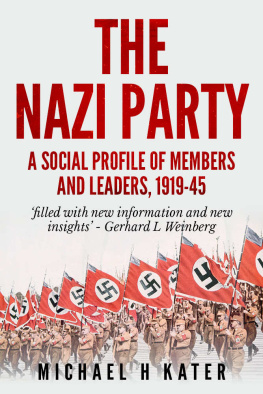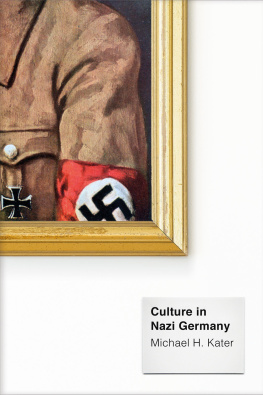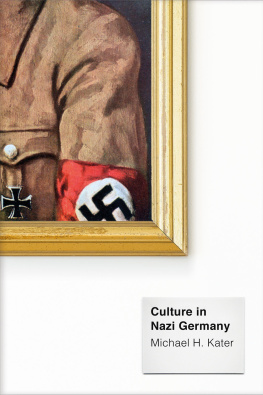THE NAZI PARTY
A Social Profile of Members and Leaders 1919-1945
Michael H. Kater
Michael H. Kater 1983
Michael H. Kater has asserted his rights under the Copyright, Design and Patents Act, 1988, to be identified as the author of this work.
First published in 1983 by Harvard University Press.
This edition published in 2016 by Albion Press Ltd.
For Jane Fair and Frank Falco, composers, teachers, and jazz musicians par excellence, whose artistry and friendship are a constant source of inspiration
Table of Contents
ACKNOWLEDGMENTS
In 1973-74 I was in Munich on sabbatical leave. An old friend from Heidelberg days, Professor Wolfgang Schieder, now at the University of Trier, asked me to participate in a panel he was organizing for the West German Historical Association meeting in Brunswick in October 1974. I was to speak on changes in the social composition of the Nazi movement during Hitlers coming to power. Out of my paper for the Brunswick conference a preliminary examination of occupations and classes chiefly in the Nazi party membership grew further articles over the next eight years: articles on the SS, on the Brown Shirts, on the Hitler Youth, and on the party itself, always with a view to comparing the social structure of each group with that of the general population and finding out what had motivated these particular Germans to become followers of Hitler when they did.
My resolve to collect material for this book and finally write it was, in part, the consequence of the encouragement of friends and colleagues in Canada, the United States, West Germany, and Austria. Richard Bauer, then acting director of the Berlin Document Center, opened the vaults of that massive archive to me until his untimely death in February 1976. The present director, Major Daniel P. Simon, could not have been more helpful in later years. His two assistants, Werner Pix and Egon Burchartz, ably guided me through the impressive records. In assembling my statistical data there, 1 was loyally aided for two summers by Hans Oppermann of the Toronto Goethe Institute. Archivists in more than thirty West German and Austrian archives advised and assisted me as my research proceeded, among them, first and foremost, Dr. Heinz Boberach of the Federal Archive in Koblenz. I was fortunate to have the opportunity to peruse many books and articles in the well-stocked Munich Institute of Contemporary History, where Professor Martin Broszat and Hellmuth Auerbach looked after me. In addition, I made use of the large bibliographical collection in the Bavarian State Library. Most of the printed material came to me through the good offices of York Universitys interlibrary loan service, whose three marvelous and never-tiring experts, Mary Hudecki, Susan Partridge, and Gary MacDonald, deserve my gratitude.
The research for this book involved the gathering of machine-read-able mass data, computer processing, and multiple statistical analyses, an extremely time-consuming and expensive process. I could not have attempted it without funding and institutional support. The Killam Program of the Canada Council (Ottawa) freed me from all academic responsibilities for two years and provided more than generous research funds. Also very supportive in a variety of ways were the Guggenheim Foundation (New York), the Alexander von Humboldt-Stiftung (Bonn), the Grants and Leave Fellowship programs of the Canada Council (Ottawa), and the Social Science and Humanities Research Council of Canada (Ottawa). York University has consistently been magnanimous, notably in supporting computer programming and technology.
Special thanks must go to Rolf and Helga Steffensmeier of Wiedenbr ck, West Germany, who year after year faithfully provided me with a dependable automobile that enabled me to accomplish the complex, geographically widespread research within relatively short time spans.
Many scholars have helped me research this book. Their advice has been not only thematic, technical, and bibliographical, but also supportive, inspiring, and morale-boosting. For the sake of brevity I can only mention those who have aided me most significantly. They are Geoffrey Barraclough, Gunnar C. Boehnert, Gerhard Botz, Werner Conze, Hans-Werner Gensichen, John R. Gittins, Richard F. Hamilton, Ernst Hanisch, Eike Hennig, Georg G. Iggers, Konrad H. Jarausch, Hartmut Kaelble, Bruce Kidd, Peter R. Knights, Jurgen Kocka, George L. Mosse, Albert D. Mott, Nobuo Noda, Gerhard A. Ritter, Ronald Rogowski, Wolfgang Schieder, Lawrence D. Stokes, Henry A. Turner, Jr., and Hans-Ulrich Wehler.
A few scholars have gone beyond the call of duty to facilitate the publication of this book. Gerhard Arminger and Michael Cowles shared their expert knowledge of statistics and computer technology. Three distinguished experts in the field of Nazi studies have read all or parts of the completed manuscript and have made valuable suggestions for improvement: Hans Mommsen, Gerhard L. Weinberg, and especially William S. Allen, who also commented intelligently on parts of the ongoing research during an American Historical Association annual meeting in Dallas years ago.
Words of thanks are due to the people who helped me write and produce this book. Katarina Rice of Harvard University Press proved to be a very perceptive and sympathetic editor; she was a joy to work with. Dorothy and Leonard C. Whitneys editorial guidance at an earlier stage was invaluable; they themselves know best what they have done to improve the manuscript. Finally, Aida D. Donald, editor for the social sciences at Harvard Press, must be thanked, not only for her awesome professionalism but also for her patience, constant admonition, and personal encouragement over the years.
Any scholar with a wife and two pre-teenage daughters knows what it means to write a book and try to keep the family together at the same time. My younger daughter, Anja, was born in Toronto on the very same day I returned from that historic conference in Brunswick in the fall of 1974. Since then, the patience of Barbara, Eva, and Anja Kater has defied any attempts at description.
The assistance of many individuals has enabled me to publish this book. I am grateful to all of them. Although I have benefited from their understanding, criticism, and advice, they cannot be held responsible for any mistakes the book may still contain. That responsibility is mine alone.
ABBREVIATIONS
ADGB: Allgemeiner Deutscher Gewerkschaftsbund; General German Trade Union
Afa: Allgemeiner freier Angestelltenbund; General free White-Collar Workers Union
BDM: Bund Deutscher Mdel; League of German Girls
BNSDJ: Bund Nationalsozialistischer Deutscher Juristen; League of National Socialist German Jurists
BVP: Bayerische Volkspartei; Bavarian Peoples Party
DAF: Deutsche Arbeitsfront; German Labor Front
DAP: Deutsche Arbeiterpartei; German Workers Party
DDP: Deutsche Demokratische Partei; German Democratic Party
DHV: Deutscher Handlungsgehilfen-Verband; German Shop Clerks Association
DNVP: Deutschnationale Volkspartei; German National Peoples Party
DVP: Deutsche Volkspartei; German Peoples Party
HJ: Hitlerjugend; Hitler Youth
KdF: Kraft durch Freude; Strength through Joy
KPD: Kommunistische Partei Deutschlands; Communist Party of Germany
KVD: Kassenarztliche Vereinigung Deutschlands; Association of German Health Insurance Physicians
NPEA: Nationalpolitische Erziehungsanstalten; National Political Training Schools
NS-Hago: Nationalsozialistische Handels-, Handwerks-und Gewerbeor-ganisation; National Socialist Tradesmens and Craftsmens Association
NSBO: Nationalsozialistische Betriebszellenorganisation; National Socialist Shop Organization
NSDAP: Nationalsozialistische Deutsche Arbeiterpartei; National Socialist German Workers Party
Next page











